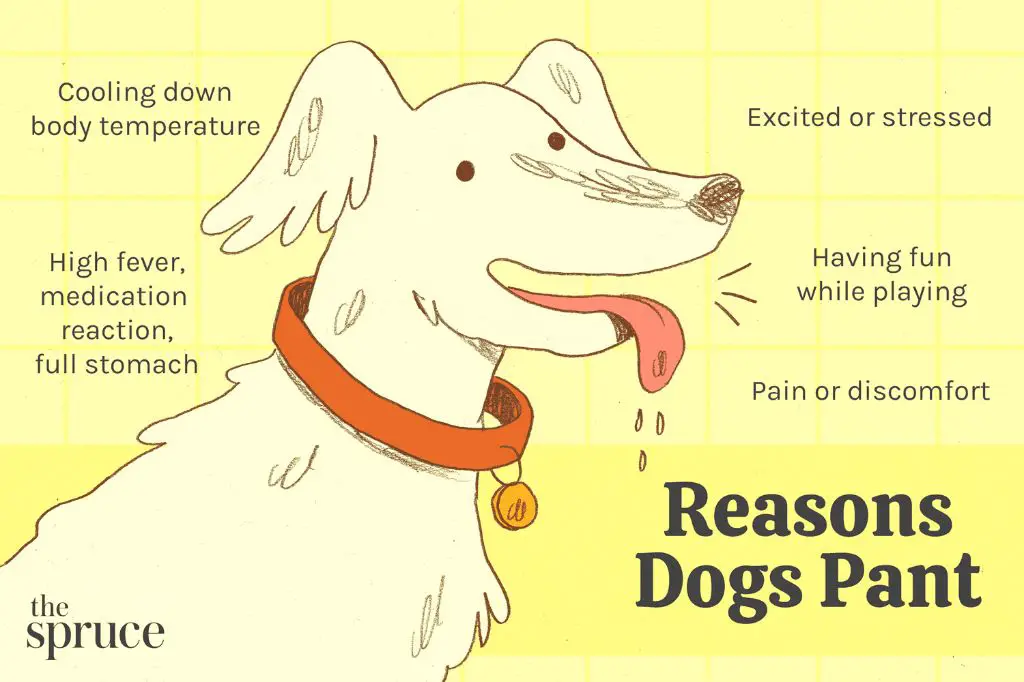Introduction

Congestive heart failure (CHF) is a life-limiting disease common in older dogs. It occurs when the heart can no longer pump efficiently, leading to fluid buildup in the lungs and abdomen. While medications and lifestyle changes can help manage CHF, it is a progressive disease and most dogs will eventually reach an advanced stage. At this point, difficult decisions need to be made about whether it is time to euthanize your dog. This article provides an overview of CHF and its stages, quality of life considerations, and guidance on making this difficult decision with your veterinarian.
Symptoms of CHF
The most common symptoms of congestive heart failure (CHF) in dogs include persistent coughing, breathing difficulties, and fatigue. According to VCA Animal Hospitals, the most common clinical sign of CHF is “persistent coughing accompanied by difficulty breathing” (Source). This is mainly due to the buildup of fluid in the lungs caused by heart failure.
Coughing in dogs with CHF can occur even when at rest. As the American Kennel Club notes, dogs may have a “persistent, usually moist cough, even when the dog is resting or sleeping” (Source). The cough is often soft and moist-sounding as fluid accumulates in the lungs.
In addition to coughing, dogs with CHF often experience shortness of breath and breathing difficulties. This can include panting, rapid breathing, or gasping for air even with minimal activity. According to Smalldoorvet, common signs include “difficulty breathing / shortness of breath” and an “inability to exercise” (Source). As the heart fails, it cannot pump enough blood and oxygen to meet the dog’s needs.
Fatigue and tiredness are also common in dogs with CHF. Dogs may seem very weak or lethargic and unwilling to engage in normal activity. They tire more easily due to impaired blood circulation.
Diagnosing CHF
The first step your veterinarian will take in diagnosing CHF is performing a physical exam. They will listen to your dog’s heart and lungs with a stethoscope to check for abnormal sounds like heart murmurs, abnormal rhythms, and crackling lung sounds that can indicate fluid accumulation. The vet will also check for symptoms like coughing, labored breathing, lethargy, and swollen abdomen.
Chest x-rays are an essential diagnostic tool for CHF. X-rays allow the vet to evaluate the size and shape of the heart and to look for an enlarged heart or fluid in or around the lungs. Changes seen on x-rays, along with clinical signs and physical exam findings, are used to definitively diagnose CHF.
Your vet may also recommend blood work such as a complete blood count and biochemistry profile. These tests evaluate organ function and look for issues with the kidneys, liver, protein levels, and red blood cell counts that could complicate treatment.
According to the VCA, echocardiograms, ECGs, and cardiac catheterization with angiograms are sometimes used to evaluate the underlying cause of CHF and determine the best treatment options.
Staging CHF
Congestive heart failure in dogs is staged from 1 to 4 based on the severity of symptoms. Knowing the stage can help determine treatment options and prognosis.
Stage 1: The dog’s heart is beginning to deteriorate but there are no symptoms yet. With early diagnosis and treatment, dogs in stage 1 can live normal life spans.
Stage 2: Symptoms like panting, shortness of breath, and fatigue, especially with exercise, start to appear. Medications can help manage the symptoms. With treatment, dogs in stage 2 may live 1-3 years.

Stage 3: Symptoms worsen and fluid starts to build up in the lungs or abdomen. Hospitalization may be needed to stabilize the dog. With aggressive treatment, dogs in stage 3 may live 4-12 months.
Stage 4: The final stage where breathing is labored even at rest. Fluid accumulates rapidly requiring drainage. Quality of life declines substantially. With only supportive care, dogs in stage 4 may only live a few weeks or months.1
The earlier CHF is diagnosed, the better the long-term outlook. Annual vet exams can detect it at stage 1. Staying up to date on medications and monitoring symptoms is key to slow progression.
Treatment Options
There are several treatment options available for dogs with CHF to help manage the condition and improve their quality of life. The main treatments include medications, oxygen therapy, and dietary changes.
Medications commonly prescribed for CHF in dogs include:1
- Diuretics like furosemide to reduce fluid buildup
- ACE inhibitors like enalapril to relax blood vessels
- Positive inotropes like pimobendan to strengthen the heartbeat
- Vasodilators to open blood vessels and lower blood pressure
Oxygen therapy may be needed for dogs struggling with breathing difficulties. This provides extra oxygen to relieve shortness of breath and improve oxygen circulation.2

Dietary changes involve restricting sodium to avoid fluid retention and providing high quality, digestible protein to avoid malnutrition.2 Vitamin supplements may also be recommended.
Monitoring Quality of Life
One of the most important things when managing a dog with congestive heart failure is closely monitoring their quality of life. As the disease progresses, it’s critical to track any changes in your dog’s mobility, appetite, and overall happiness. Look for signs like difficulty breathing, coughing, lack of energy, loss of interest in food or favorite activities, and changes in attitude or temperament.
There are some helpful quality of life questionnaires that allow owners to objectively assess and quantify their pet’s wellbeing. The Tufts University Quality of Life Questionnaire and the Cardiac Health-Related Quality of Life Questionnaire are two validated resources you can use. Tracking your dog’s quality of life over time provides important data to help inform conversations with your veterinarian.
Look for any deterioration in your dog’s condition and make adjustments to their treatment plan accordingly. Your vet may recommend changes in medications, dosages or diet. However, there may come a point where your dog’s quality of life is too compromised, which leads to the difficult question of euthanasia. Regular monitoring and open communication with your vet gives you the best information to make that decision when the time comes.
When to Consider Euthanasia
As CHF progresses, your dog’s quality of life can deteriorate to the point where euthanasia may be the most humane option. There is no single right time to make this difficult decision, but there are some signs that indicate your dog’s condition has declined to a point where continuing treatment would prolong suffering:
Severe breathing problems – Your dog struggles heavily to breathe even with oxygen therapy and cannot get comfortable or rest.
No appetite – Your dog has completely lost interest in food and drinks very little water.
Severe lethargy – Your dog has no interest in any activity and cannot stand on their own.
Coughing fits – Your dog has frequent, intense coughing fits that leave them exhausted.
Collapse – Your dog frequently collapses or loses consciousness.
Distress – Your dog cries or whimpers frequently and seems to be in constant pain or distress.
Poor response to medications – Your dog’s symptoms are no longer managed well by medications.
Difficulty passing stool – Your dog strains excessively and is constipated.
If your vet determines your dog’s quality of life is very poor, with no expectation of improvement, it may be time to consider euthanasia. Focus on your dog’s comfort above all else when making this decision. Source: Signs of a Dog Dying of Congestive Heart Failure (CHF)
Making the Decision
Making the decision to euthanize your dog due to CHF is never easy. It is an extremely difficult choice, but often a necessary one to prevent further suffering. The most important factor is always your dog’s quality of life and comfort.
Before making any final decisions, have an honest discussion with your veterinarian about your dog’s prognosis and options. Your vet can help assess your dog’s condition, symptoms, and whether treatments are still effectively managing the CHF. They can provide guidance on signs that your dog’s quality of life is declining to an unacceptable level.
Focus on what will bring your dog the most comfort in their final days. This may mean providing extra love and affection, minimizing stressful activities, allowing them to rest as needed, and making them as comfortable as possible. Work closely with your vet to ensure your dog’s pain is properly managed.
While the decision is heartbreaking, choosing euthanasia can be the final act of love and kindness we give our pets at the end of their lives. It spares them further suffering and distress. Take comfort in knowing you are doing right by your dog.
The Euthanasia Process
The euthanasia process usually happens at the veterinarian’s office. Your vet will start by giving your dog a sedative, either through an injection or orally, to relax them. Once your dog is calm and sedated, the vet will insert an IV catheter and inject the euthanasia solution, usually containing pentobarbital. This will quickly render your dog unconscious, stop their breathing and heart, and result in a peaceful death usually within minutes (AVMA).

Some pet owners may opt for at-home euthanasia, which allows your dog to be euthanized in a familiar environment. A vet will come to your home to administer sedation and inject the euthanasia solution. At-home euthanasia can provide comfort but does come at an additional cost (PetMD). Whether at the vet or at home, the euthanasia process is designed to be gentle, stress-free, and painless for your beloved dog.
Coping With Loss
Losing a beloved pet can be extremely painful. The grief of losing your pet may be as intense as losing a friend or family member. There is no right or wrong way to grieve, but there are some healthy ways to cope with your loss.
Acknowledge your grief, and give yourself permission to mourn (Human Society, 2023). Allow yourself to cry and express your feelings of sadness and loss. The silence in your home may feel overwhelming, especially if you live alone. Play music or turn on the TV to help fill the quiet space as you adjust.
Consider having a memorial service for your pet (Helpguide, 2023). This can be a small gathering of family and friends or a private moment of reflection. Light a candle, share memories and photos, read a poem, or bury your pet with a favorite toy. Finding meaning in the loss can bring some comfort.
Talk to friends, family, or a pet loss support hotline. Sharing stories about your pet can help you process the grief. Consider joining a pet loss support group, talking to a counselor, or finding support online. Knowing you are not alone in your grief can be very comforting.
Take care of yourself through rest, nutrition and light exercise. Grief can be emotionally and physically draining. Maintain a routine and do activities you enjoy. With time, the intense pain will subside.